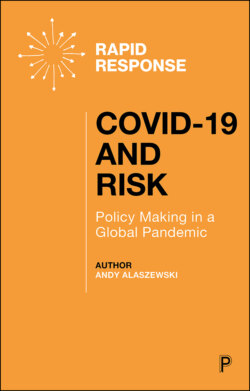Читать книгу COVID-19 and Risk - Alaszewski Andy - Страница 19
На сайте Литреса книга снята с продажи.
Tensions over the framing of COVID in the US
ОглавлениеIn the US, the flu/herd immunity frame played a central part in the policy debate. At the start of 2020 there was consensus amongst US policy makers that the virus was flu-like and not a high risk. This consensus shifted in March 2020 as the reality of the high level of infection and lethal nature of the disease became evident. In the summer of 2020 as the US Presidential election approached, experts continued to emphasise the dangerousness of COVID-19 but President Trump and his inner advisers returned to their initial framing and minimising of the risks.
From the start of the pandemic, the President had access to sophisticated and up-to-date information. On 23 January when the Chinese authorities announced a lockdown in the city of Wuhan, Trump was informed by his chief security briefer that the new disease was ‘Just like flu. We don’t think it’s as deadly as SARS’ (Woodward, 2020a, p. 230). On 31 January, Trump and his Health Secretary, Alex Azar, were briefed by two leading experts on infectious disease: Anthony Fauci (Director of the National Institute of Allergy and Infectious Diseases) and Robert Redfield (Director of the Centers for Disease Control and Prevention [CDC]). Fauci was keen to stress the uncertainties associated with the new disease. He is reported as saying: ‘it’s all uncharted waters. That’s why we’re reacting. Because of what we’re seeing is happening in China. It’s devastating the place. So whatever the hell is going on in China right now is a hell of lot different than a regular flu season’ (Woodward, 2020a, p. 235).
Fauci also stressed that this new disease was also different to SARS as it was easily transmitted from person to person and could be transmitted by individuals who did not show any symptoms (Woodward, 2020a, p. 235). At this meeting, the President accepted advice that he should announce travel restrictions on individuals travelling from China.
By February, COVID-19 had reached the US and was spreading in California and New York. However, the administration chose to downplay the dangers, framing it as flu. On 27 February, the Health Secretary, Alex Azar, in evidence to the House of Representatives observed that: ‘The immediate risk to the public [in the US] remains low… it will look and feel to the American people more like a severe flu season’ (Woodward, 2020a, p. 254). At this time the experts, Fauci and Redfield, publicly supported this downplaying of the risk of COVID-19. On the Today Show on 29 February, Anthony Fauci stated that: ‘Right now the risk is still low, but this could change’ (Woodward, 2020a, p. 254).
In March there was further evidence of community transmission and that the virus was spreading rapidly in Europe. On 9 March, stock markets round the world recorded their sharpest drop in a decade. Donald Trump tried to reassure people by tweeting that deaths from ‘common Flu’ were 27,000 to 70,000 a year but that there were only 546 COVID-19 cases in the US and 22 deaths (Woodward, 2020a, p. 275). Despite these reassurances, the US took measures to control the spread of the virus. On 11 March, the President signed a decree restricting travel with Europe and he announced measures that amounted to a national lockdown (Woodward, 2020a, pp. 280–2).
Across the summer and autumn of 2020 there was conflict between experts, especially Fauci and the Trump administration. For example, Fauci warned that the ‘death toll would be enormous’ (Higgins-Dunn, 2020) and that the US could ‘not possibly be placed more poorly’ to meet the threat of COVID-19. John Deere, a White House spokesman, called Fauci’s remarks unacceptable and suggested that Fauci was criticising the President (Yahoo News, 2020). In September 2020, Trump again suggested that that the virus would go away without a vaccine because ‘You’ll [the US population] develop like a herd mentality [immunity]. It’s going to be herd-developed and that’s gonna happen’ (Mazza, 2020).
